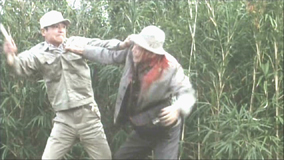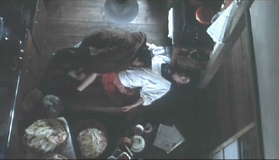Vengeance is Mine (Shohei Imamura, 1979)
 Shohei Imamura’s Vengeance is Mine deftly
combines cold impartiality and unerring perceptiveness to create one of the most
impressive and troubling serial killer movies of all time. Based on true events,
the film chronicles the murderous rampage of one Iwao Enokizu (Ken Ogata) who,
over the course of a 78-day crime spree, habitually killed and robbed countless
victims. At the beginning of the movie, Imamura shows us Iwao’s eventual
capture, and the distancing effect contributes a great deal toward keeping the
movie from exploiting the crimes in the way that a typical suspense film would.
Throughout the movie, Imamura’s extreme formalism minimalizes the amount of
traditional suspense that the audience can feel. Most films employ shakier
camera movements during action scenes, but Imamura has a tendency here to grow
more still whenever his characters behave most extremely, and that gives the
impression that it’s at those times that he finds them most inscrutable. While
there are individual shots that create some traditional suspense, they are the
exception to the rule, since any move to paint Iwao as a villain would place
judgment on him that Imamura seems to feel is undue. After the audience is shown
Iwao’s first few murders in graphic detail, most of them are moved off screen
and relayed to the audience through dialogue or snippets of police reports to
minimize any prurient impulses that might arise from their presentation.
Shohei Imamura’s Vengeance is Mine deftly
combines cold impartiality and unerring perceptiveness to create one of the most
impressive and troubling serial killer movies of all time. Based on true events,
the film chronicles the murderous rampage of one Iwao Enokizu (Ken Ogata) who,
over the course of a 78-day crime spree, habitually killed and robbed countless
victims. At the beginning of the movie, Imamura shows us Iwao’s eventual
capture, and the distancing effect contributes a great deal toward keeping the
movie from exploiting the crimes in the way that a typical suspense film would.
Throughout the movie, Imamura’s extreme formalism minimalizes the amount of
traditional suspense that the audience can feel. Most films employ shakier
camera movements during action scenes, but Imamura has a tendency here to grow
more still whenever his characters behave most extremely, and that gives the
impression that it’s at those times that he finds them most inscrutable. While
there are individual shots that create some traditional suspense, they are the
exception to the rule, since any move to paint Iwao as a villain would place
judgment on him that Imamura seems to feel is undue. After the audience is shown
Iwao’s first few murders in graphic detail, most of them are moved off screen
and relayed to the audience through dialogue or snippets of police reports to
minimize any prurient impulses that might arise from their presentation.
 Since Iwao is a real figure, Imamura
appropriately treats his existence as an unquestionable fact instead of as a
glorified metaphor. Though he is always probing the character’s motivation, he
presents him neither as an unquestionable scourge to society nor someone who
operates above its rules. Because of the sheer objectivity of Imamura’s style,
the responsibility can’t rest comfortably with any one party, nor can the
simple classification of Iwao as a psychopath answer enough of the audience’s
questions about him. We find that Iwao has a devout Catholic background, a
troubled marriage, a previous criminal record, and an insatiable sexual
appetite, but none of those factoids satisfactorily explain what it is that
makes him explode into violence. True to the themes that exist in his other
films, Imamura most seems to think Iwao’s unchecked primal impulses are to
blame. In one early scene, we see Iwao, who has just murdered someone, wash the
blood off of his hands by urinating on them. Right afterward, he takes a
persimmon from a nearby tree with his unclean hands and takes a bite from it,
only to discard it when he finds it unacceptable. Something about his nature
becomes clear. When he loses control of his sanity, he is living in the moment,
and essentially overriding any checks put on his behavior by society in his
pursuit of transitory pleasures.
Since Iwao is a real figure, Imamura
appropriately treats his existence as an unquestionable fact instead of as a
glorified metaphor. Though he is always probing the character’s motivation, he
presents him neither as an unquestionable scourge to society nor someone who
operates above its rules. Because of the sheer objectivity of Imamura’s style,
the responsibility can’t rest comfortably with any one party, nor can the
simple classification of Iwao as a psychopath answer enough of the audience’s
questions about him. We find that Iwao has a devout Catholic background, a
troubled marriage, a previous criminal record, and an insatiable sexual
appetite, but none of those factoids satisfactorily explain what it is that
makes him explode into violence. True to the themes that exist in his other
films, Imamura most seems to think Iwao’s unchecked primal impulses are to
blame. In one early scene, we see Iwao, who has just murdered someone, wash the
blood off of his hands by urinating on them. Right afterward, he takes a
persimmon from a nearby tree with his unclean hands and takes a bite from it,
only to discard it when he finds it unacceptable. Something about his nature
becomes clear. When he loses control of his sanity, he is living in the moment,
and essentially overriding any checks put on his behavior by society in his
pursuit of transitory pleasures.
 As Imamura continues to study Iwao, he
uncovers further layers of his behavior, and always attempts to achieve a deeper
understanding of him by refusing to settle for comfortable solutions to the
puzzle of his character. Though Iwao’s realization of the horrors that he’s
capable of turn him into a nihilist, he still has a profound desire for freedom
that makes him continue running. When he returns from prison and finds his wife
has slept with another man, he still is programmed enough by society to be
outraged by her transgression. Imamura is always changing his perspective on
Iwao so that it’s impossible to see him as a stock character. As in most of
the director’s work, there are darkly humorous moments (the best of which play
like a bastardized Ozu movie) squeezed alongside
horrifically brutal ones. All of the contradictions in Iwao essentially
undermine the audience’s ability to pigeonhole him, and make the movie
register on a deeper level than if were content to turn him into a monster. The
meekness of those that Iwao meets during his reign of terror clearly critiques
our willingness to be complacent, whether through fear or ignorance, with
unknown forces. His film constantly investigates its protagonist so that the
audience can’t ever feel that sort of acceptance of such an unnatural presence
yet at the same time suggests that a society that can ignore the warning signs
that Iwao sends off is itself unnatural. Quite literally, Imamura has created
here a protagonist that’s impossible to put easily to rest, and the
ramifications of his examination reflect upon us all by showing how much we’re
willing to ignore to achieve piece of mind. Though at the end of Vengeance is
Mine the audience might not understand the motives of the murderer clearly,
it’s almost inevitable that they will exit the film with a heightened sense of
the complexities of human nature.
As Imamura continues to study Iwao, he
uncovers further layers of his behavior, and always attempts to achieve a deeper
understanding of him by refusing to settle for comfortable solutions to the
puzzle of his character. Though Iwao’s realization of the horrors that he’s
capable of turn him into a nihilist, he still has a profound desire for freedom
that makes him continue running. When he returns from prison and finds his wife
has slept with another man, he still is programmed enough by society to be
outraged by her transgression. Imamura is always changing his perspective on
Iwao so that it’s impossible to see him as a stock character. As in most of
the director’s work, there are darkly humorous moments (the best of which play
like a bastardized Ozu movie) squeezed alongside
horrifically brutal ones. All of the contradictions in Iwao essentially
undermine the audience’s ability to pigeonhole him, and make the movie
register on a deeper level than if were content to turn him into a monster. The
meekness of those that Iwao meets during his reign of terror clearly critiques
our willingness to be complacent, whether through fear or ignorance, with
unknown forces. His film constantly investigates its protagonist so that the
audience can’t ever feel that sort of acceptance of such an unnatural presence
yet at the same time suggests that a society that can ignore the warning signs
that Iwao sends off is itself unnatural. Quite literally, Imamura has created
here a protagonist that’s impossible to put easily to rest, and the
ramifications of his examination reflect upon us all by showing how much we’re
willing to ignore to achieve piece of mind. Though at the end of Vengeance is
Mine the audience might not understand the motives of the murderer clearly,
it’s almost inevitable that they will exit the film with a heightened sense of
the complexities of human nature.
07-16-03
83
Jeremy Heilman